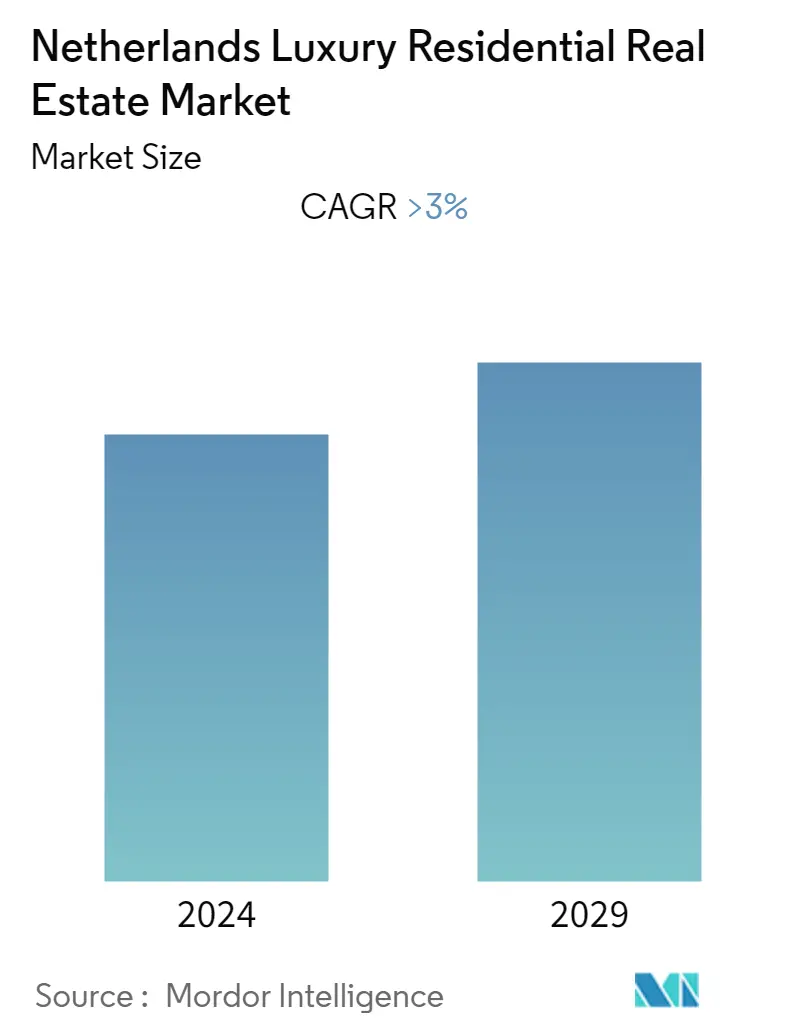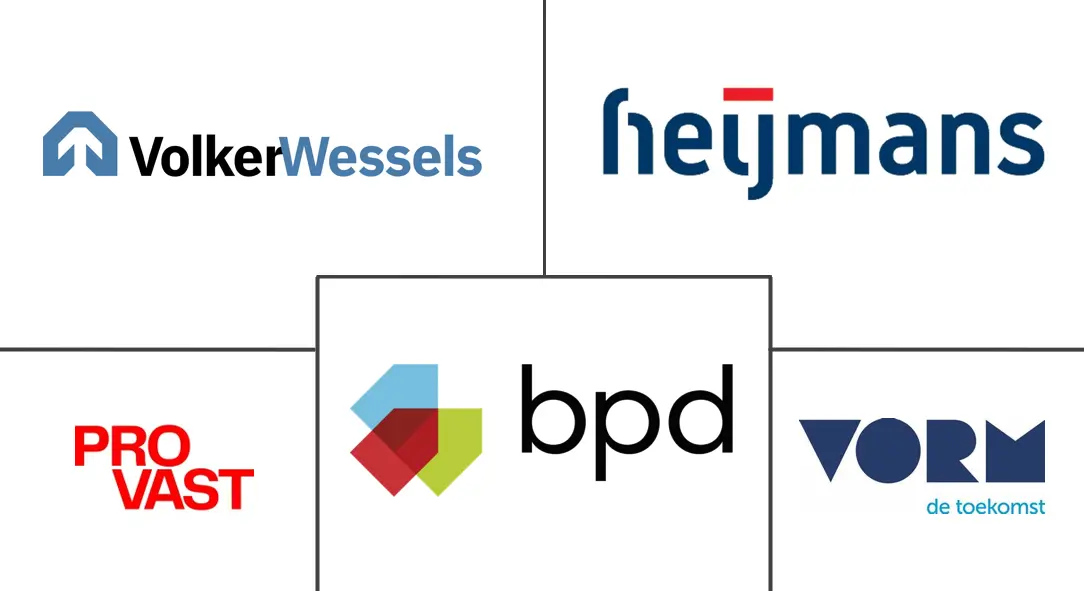Market Size of Netherlands Luxury Residential Real Estate Industry

| Study Period | 2020 - 2029 |
| Base Year For Estimation | 2023 |
| Forecast Data Period | 2024 - 2029 |
| Historical Data Period | 2020 - 2022 |
| CAGR | 3.00 % |
| Market Concentration | Medium |
Major Players
*Disclaimer: Major Players sorted in no particular order |
Netherlands Luxury Residential Real Estate Market Analysis
The Netherlands Luxury Residential Real Estate Market is around USD 4.2 billion in the current year and is anticipated to register a CAGR of over 5% during the forecast period.
- The luxury residential real estate market increased in the past three years due to the COVID-19 pandemic. The demand for luxury properties grew much faster than the residential market. COVID led to a renewed focus on living spaces. Affluent people are no longer looking at real estate as just an investment. They are looking for living spaces where they can experience the serenity and enjoy outdoor spaces such as gardens and terraces rather than indoor spaces. Also, many people in the middle class are searching for better homes that encourage work-from-home policies.
- The growth in the market is driven by the growing number of High Net Worth Individuals (HNWIs). These HNWIs want to diversify their portfolio with non-traditional investments instead of equities and bonds, including luxury real estate. Investors in the Netherlands buy luxury property for two main reasons. First, for leisure purposes - owning a holiday home they can use in their free time and second, to earn an income. They buy property for rental income and capital gains. The number of people buying luxury real estate for rental income increased in the past 2-3 years.
- The increasing popularity of micro-trips also impacted the luxury homes market. Micro-travel - a short trip of fewer than five days - is one of the hottest trends in the luxury travel market. Therefore, seeking rental income from luxury real estate is the obvious choice for investors. Luxury real estate buyers looking for rental income prefer investing in apartments rather than villas, mansions, or detached houses. Luxury property buyers prefer residential real estate in central areas of cities rather than suburbs.
Netherlands Luxury Residential Real Estate Industry Segmentation
Luxury residential real estate is large houses with opulent designs and amenities at prime locations. The report covers market dynamics and insights, such as government regulations, technological trends, etc. Additionally, the report provides company profiles to understand the market's competitive landscape.
The Netherlands luxury residential real estate market is segmented by type (apartments, condominiums, villas, and landed houses) and cities (Amsterdam, Rotterdam, The Hague, and other cities). The report offers market sizes and forecasts in value (USD billion) for all the above segments.
| By Type | |
| Apartments and Condominiums | |
| Villas and Landed Houses |
| By City | |
| Amsterdam | |
| Rotterdam | |
| The Hague | |
| Other Cities |
Netherlands Luxury Residential Real Estate Market Size Summary
The Netherlands luxury residential real estate market is experiencing significant growth, driven by a shift in consumer preferences and an increase in High Net Worth Individuals (HNWIs). The COVID-19 pandemic has accelerated the demand for luxury properties, as affluent buyers seek homes that offer outdoor spaces and a serene living environment, rather than just traditional investment properties. This trend is further supported by the rising number of HNWIs in the Netherlands, who are diversifying their portfolios with luxury real estate for both leisure and rental income purposes. The popularity of micro-travel has also contributed to the market's expansion, with investors preferring apartments in central urban areas for rental income, aligning with the trend of short-term luxury stays.
The market is characterized by a semi-consolidated structure, with both local and international players such as BPD, Provast, Vorm, Volker Wessels, and Heijmans actively participating. The integration of technology into luxury living is redefining the market, as buyers increasingly seek smart homes equipped with advanced features like AI and ML. This technological shift is enhancing the appeal of luxury properties, offering convenience and improved quality of life. The presence of international funds and foreign capital is encouraging domestic developers to engage in joint ventures, strengthening their market position. Innovations such as 3D modeling for property purchases are also emerging, reflecting the market's adaptation to modern consumer expectations.
Netherlands Luxury Residential Real Estate Market Size - Table of Contents
-
1. MARKET INSIGHTS AND DYNAMICS
-
1.1 Market Overview
-
1.2 Market Dynamics
-
1.2.1 Market Drivers
-
1.2.2 Market Restraints
-
1.2.3 Market Opportunities
-
-
1.3 Industry Attractiveness - Porter's Five Forces Analysis
-
1.3.1 Bargaining Power of Suppliers
-
1.3.2 Bargaining Power of Buyers/Consumers
-
1.3.3 Threat of New Entrants
-
1.3.4 Threat of Substitute Products
-
1.3.5 Intensity of Competitive Rivalry
-
-
1.4 Value Chain / Supply Chain Analysis
-
1.5 Industry Policies and Regulations
-
1.6 Technological Developments in the Sector
-
1.7 Impact of COVID-19 on the Market
-
-
2. MARKET SEGMENTATION
-
2.1 By Type
-
2.1.1 Apartments and Condominiums
-
2.1.2 Villas and Landed Houses
-
-
2.2 By City
-
2.2.1 Amsterdam
-
2.2.2 Rotterdam
-
2.2.3 The Hague
-
2.2.4 Other Cities
-
-
Netherlands Luxury Residential Real Estate Market Size FAQs
What is the current Netherlands Luxury Residential Real Estate Market size?
The Netherlands Luxury Residential Real Estate Market is projected to register a CAGR of greater than 3% during the forecast period (2024-2029)
Who are the key players in Netherlands Luxury Residential Real Estate Market?
BPD, Provast, Vorm, Volker Wessels and Heijmans are the major companies operating in the Netherlands Luxury Residential Real Estate Market.

